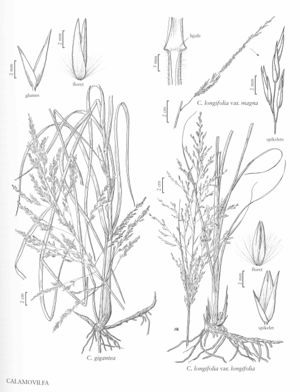Difference between revisions of "Calamovilfa longifolia var. magna"
Treatment appears in FNA Volume 25. Treatment on page 142.
FNA>Volume Importer |
imported>Volume Importer |
||
| (2 intermediate revisions by the same user not shown) | |||
| Line 38: | Line 38: | ||
|publication year= | |publication year= | ||
|special status= | |special status= | ||
| − | |source xml=https:// | + | |source xml=https://bitbucket.org/aafc-mbb/fna-data-curation/src/200273ad09963decb8fc72550212de541d86569d/coarse_grained_fna_xml/V25/V25_704.xml |
|subfamily=Poaceae subfam. Chloridoideae | |subfamily=Poaceae subfam. Chloridoideae | ||
|tribe=Poaceae tribe Cynodonteae | |tribe=Poaceae tribe Cynodonteae | ||
Latest revision as of 18:58, 11 May 2021
Sheaths usually pubescent, often densely so, rarely glabrous. Panicles to 77.5 cm long, usually 1.3-5.5 times as long as wide; branches to 33 cm long, typically widely divergent, sometimes reflexed in the lower 1/3 of the panicle. Spikelets commonly with a brownish cast, relatively loosely imbricate.
Distribution
Ill., Ind., Ont., Ohio, Mich., Wis., N.Y., Pa., Iowa
Discussion
Calamovilfa longifolia var. magna grows on dunes and sandy shores around lakes Superior, Michigan and Huron, with outlying stations in sand or sandy soils.
Selected References
None.
Lower Taxa
None.
